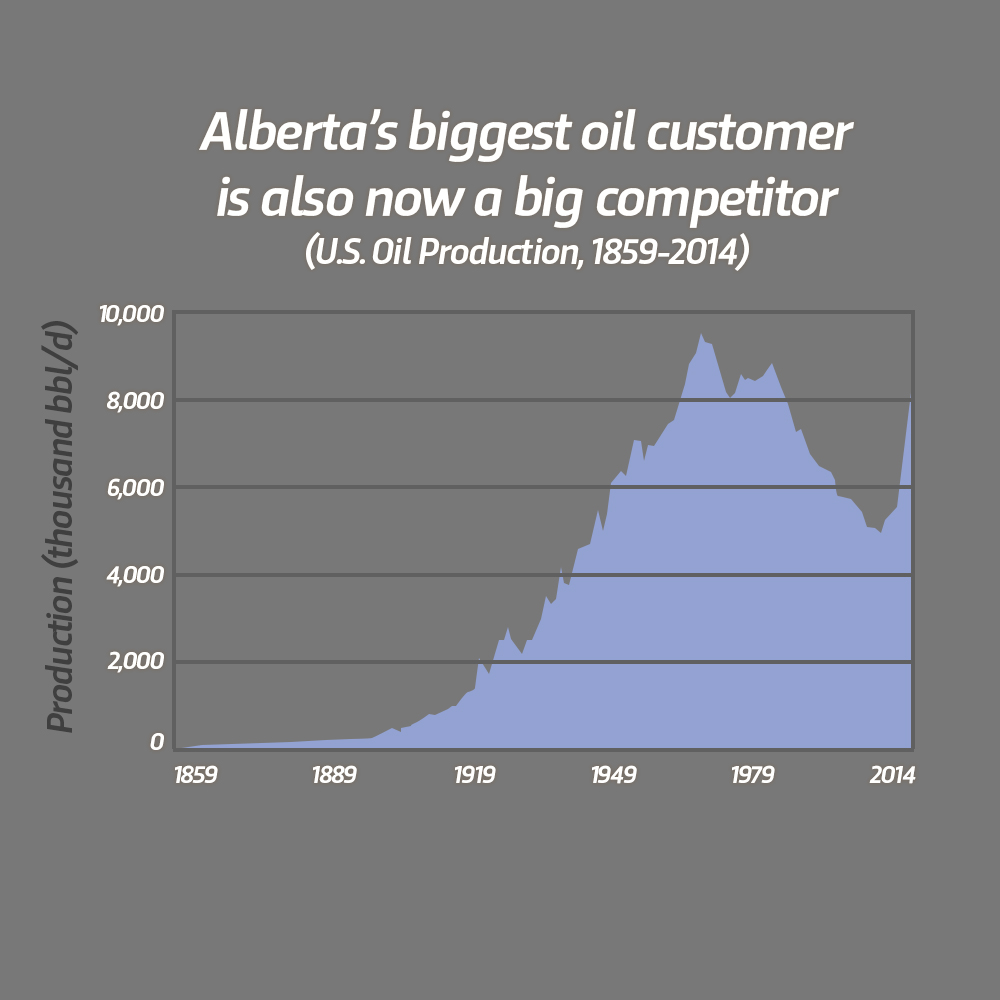Alberta, the U.S. and oil

Alberta’s biggest customer is also now a big competitor.
The global energy landscape has changed considerably over the past several years. One of the most significant changes has been the resurgence of oil production in the U.S.
The U.S. has long been an oil producer, with places such as Texas, Alaska, and the Gulf Coast being synonymous with oil. Since the beginnings of its oil industry in the late 1800s, the U.S. steadily increased its oil production, and for much time since it was the world’s largest supplier. During World War Two, the U.S. produced around half of the world’s oil supplies. In the 1950s through the 1970s, the U.S. continued to increase oil production, but production in other countries increased as well, reducing the U.S. share.
Starting in the early 1970s, U.S. oil production steadily decreased, as it became more difficult to extract oil from decades-old oil fields. By 2008, U.S. oil production had fallen to an average of 5 million barrels per day.
Around 2008, things started to change when energy companies began unlocking deposits of U.S. shale oil. Trapped in tight rock formations, shale oil had long been considered inaccessible. But advances in technology (such as horizontal drilling and multi-stage hydraulic fracturing), combined with strong oil prices, suddenly made shale oil economically feasible.
The impact of this has been dramatic. As seen in the chart above, U.S. oil production has bounced back since 2008, surging to levels not seen since the mid-1980s. In 2014, U.S. oil production averaged 8.7 million barrels per day.
What has this meant for the global energy landscape? Well, for one thing, the U.S. has been able to reduce the amount of oil it must import. As a large economy, the U.S. consumes a lot of gasoline and other refined products, so it needs a lot of oil to feed its refineries.
When its own oil production fell, the U.S. steadily increased its oil imports for decades. But since U.S. shale oil production started to take off around 2008, total oil imports by the U.S. have decreased.

Another thing to note is that U.S. shale oil production has been filling gaps in world oil supplies, helping maintain balance between global oil demand and supply.
Between 2008 and today, there have been a variety of disruptions in oil production around the world. Some of these disruptions have been technological or economic in nature, while others have been geopolitical in nature (e.g., conflicts, government instability, etc.) Rising production from U.S. shale oil has effectively off-set these disruptions.

What does this mean for Alberta?
Interestingly, the amount of oil that Alberta exports to the U.S. has not fallen. During the past number of decades, Canada has assumed a primary role as a source of stable and secure oil for the U.S. Since 1981, the U.S. has imported a steadily growing amount of oil from Canada, with the majority coming from Alberta.
These imports have continued to grow since 2008, despite the rapid growth of U.S. shale oil production and the decrease in total U.S. oil imports.

One reason for this is that several years ago, U.S. refineries modified their facilities to accept bitumen from Alberta’s oil sands. The modifications were neither cheap nor easy, and so these refineries are rather committed to buying oil from Alberta.
(Meanwhile, U.S. refineries that use light oil have the option of buying U.S. shale oil as a feedstock, and therefore do not need to import as much light oil from other countries. Hence the decrease in total U.S. oil imports.)
On the other hand, Alberta now finds that its biggest oil customer is also now a big competitor.

Remember those gaps in oil supply we talked about earlier? All of those gaps, and any future gaps between supply and demand, could theoretically be filled by Alberta. (We certainly have enough oil to fill them.) However, it’s clear that U.S. shale oil is also capable of filling those gaps.
Ten years ago, U.S. shale oil simply wasn’t an available option. Today, it’s a feasible alternative to Alberta oil.
Sources: Alberta Energy; U.S. Energy Information Administration; Alberta Energy Regulator